LN変調器(ファイバー結合型電気光学(EO)変調器)、830 nm~1090 nm
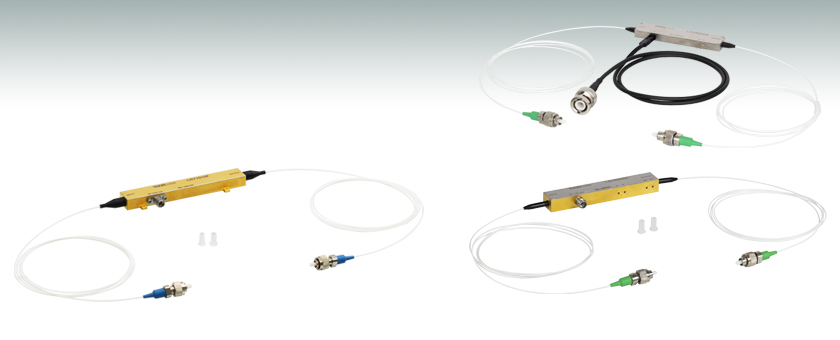
- Up to 40 GHz Lithium Niobate (LiNbO3) Modulators
- 850 nm or 1060 nm Wavelength Operation
- Annealed Proton-Exchange Waveguides
- Fiber-Coupled, High-Speed Modulation
LNY1010F
1060 nm 10 GHz Phase Modulator, FC/PC Connectors
LNY85D2A
850 nm 200 MHz Phase Modulator, FC/APC Connectors
LNX8540A
850 nm 40 GHz Intensity Modulator, FC/APC Connectors

Please Wait
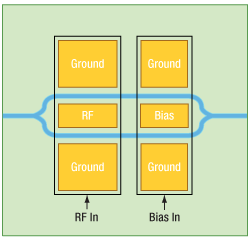
Click to Enlarge
Figure 1.2 強度変調器の光回路図。2つに分岐した光導波路(青い線)がニオブ酸リチウム(緑)の表面に形成されています。入力光は、まず変調したRFドライブ電圧、次にDCバイアス電圧の影響を受けます(図の黄色の部分)。
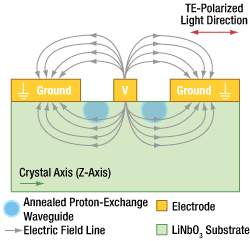
Click to Enlarge
Figure 1.1 アニールプロトン交換処理により導波路を成したXカットLN強度変調器の断面図。右上にTE偏光モードの方向が示されています。
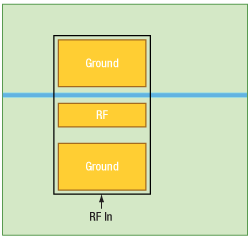
Click to Enlarge
Figure 1.3 位相変調器の光回路図。ニオブ酸リチウム(緑)上に1本の光導波路(青い線)が形成されています。入力光は、変調したRFドライブ電圧の影響のみを受けます(図の黄色の部分)。
アニールプロトン交換(APE)導波路
APE導波路は、リチウムイオンとH+などのプロトン源の交換により形成されます。導波路の形成は、ニオブ酸リチウムLiNbO3)をH+イオン濃度の高い酸に浸し、材料の屈折率を変化させることで実行されます。次に導波路を高温でアニール(徐々に加熱)し、交換領域から余分な水素を除去することで、導波路が安定します。このアニールの段階で、導波路はステップインデックスからグラディエントインデックス型に変換し、シングルモード伝搬損失が大幅に減少します。
APEの工程で、異常光の屈折率が大きくなりますが、常光の屈折率は小さくなります。これは、TE(入射面に対して横方向)偏光モードのみが伝搬することを意味します。APE導波路は、Ti拡散導波路と比べて大幅にフォトリフラクティブ効果の影響が減少しますので、より短い波長での高速変調が可能となります。
特長
- 強度(LNXシリーズ)または位相(LNYシリーズ)変調器をご用意
- 動作波長:850 nmまたは1060 nm
- アニールプロトン交換導波路
- Xカットニオブ酸リチウム(LiNbO3)
- 低挿入損失: 5 dB以下(LNXシリーズ)または4 dB以下(LNYシリーズ)
- 長期にわたって安定したバイアス
- Ti拡散導波路に比べてフォトリフラクティブの影響が小さい
- 偏波保持ファイバーピグテールの入出力
- FC/PCまたはFC/APCファイバーコネクタに対応
一般的な用途
- 量子光学
- 高速通信
- テストおよび測定
当社では、850 nmまたは1060 nmの波長に対応したLN変調器をご用意しております。こちらの高速光変調器は、アニールプロトン交換(APE)導波路の技術がベースで、光挿入損失は5 dB以下(強度変調器)または4 dB以下(位相変調器)と低く、高速変調システムの開発に適しています。
こちらの変調器は、XカットのLiNbO3から製造されています(Figure 1.1をご覧ください)。強度変調器(LNXから始まる型番)では、変調信号の周波数チャープを最小にするために対称性の設計が採用されています。マッハツェンダ干渉計の構成により、LN強度変調器の光出力の変調が可能となっております(Figure 1.2参照)。これらのデバイスには、変調器の変調駆動信号とバイアス電圧用の電気接続が含まれます。位相変調器(LNYから始まる型番)では、Xカットの導波路構造により、高い偏光消光比を維持しながら光の位相変調を行うことが可能です。Figure 1.3に位相変調器の光回路図を掲載しています。位相変調器はバイアス電圧を必要としないため、変調駆動信号の電気接続のみが含まれます。詳細については「ピン配列」のタブもご参照ください。
こちらの変調器の入出力部には、FC/PCまたはFC/APCコネクタ付きの偏波保持ファイバが付いております。コネクタのナローキーはファイバのスロー軸にアライメントされています。なお、ご希望により、片端がFC/PCコネクタ、もう片端がFC/APCコネクタの構成でご提供することも可能です。カスタム構成(コネクタ、波長など)やお見積もりについては当社までお問い合わせください。
各変調器の性能は1つ1つ工場で検査され、個々の検査結果の概要が同梱されます。検査結果と詳細なデータは、下の型番横の赤いアイコン(![]() ) をクリックし、「Download Serial Item Data」下に変調器のシリアルナンバを入力するとダウンロードが可能です。
) をクリックし、「Download Serial Item Data」下に変調器のシリアルナンバを入力するとダウンロードが可能です。
当社の校正済みE/O変換機MX40G-850には、LNX8540xシリーズ変調器が内蔵されています。変調器をレーザ、バイアスコントローラや増幅器などに組み込むカスタム構成についての詳細やお見積りについては、当社までお問い合わせください。
850 nm変調器のピン配列

Click to Enlarge
40 GHz強度変調器LNX8540FおよびLNX8540Aのピン配列図

Click to Enlarge
10 GHz位相変調器LNY8510FおよびLNY8510Aのピン配列図

Click to Enlarge
200 MHz位相変調器LNY85D2FおよびLNY85D2Aのピン配列図
1060 nm変調器のピン配列

Click to Enlarge
20 GHz強度変調器LNX1020FおよびLNX1020Aのピン配列図

Click to Enlarge
40 GHz強度変調器LNX1040FおよびLNX1040Aのピン配列図

Click to Enlarge
200 MHz位相変調器LNY10D2FおよびLNY10D2Aのピン配列図
 Click to Enlarge
Click to Enlarge10 GHz位相変調器LNY1010FおよびLNY1010Aのピン配列図
| Posted Comments: | |
user
(posted 2025-09-25 12:47:54.807) I want to use the LNY1010A for spectral broadening of a 1064nm fiber laser. For this, i want to modulate with White Noise.
The maximum RF Input power of the LNY1010A is +25dBm. Is this the average power?
For the same peak-peak voltage, the average power of white noise is 8-12dBm lower compared to the average power of a continuous sine wave.
Will the EOM be damaged if i apply white noise with +25dBm average power? At this power, the peak-peak voltage of the white noise is 33-37dBm. tdevkota
(posted 2025-10-08 08:43:14.0) Thank you for contacting Thorlabs. Unfortunately, we cannot guarantee safe operation above +25 dBm peak power, so testing beyond that would be at your own risk. I have reached out to you directly to further discuss your application. Itay S
(posted 2025-07-18 21:12:29.513) Do you have information on the phase modulation performance of the LNY8510A up to 20 GHz modulation frequency? How fast is the drop-off in the response?
Thank you. tdevkota
(posted 2025-09-15 09:23:24.0) Thank you for contacting Thorlabs. You can find typical electro-optic response data that goes up to 20GHz under the Overview tab: please click on the blue info icon in the specs table (Info column), go to Electro-Optic Response tab and click on the link for the raw data below the plot. As you can see in the plot, unlike photodiodes or other types of electrical devices, the falloff after ~3dB point is not exponential, so the modulator is "useable" at higher frequencies. Zeyan Zhang
(posted 2025-05-29 02:45:57.83) I'd like to use the LNY8510 at 918 nm. I know the spec says a max wavelength of 870 nm.Is their any negative effects? Thanks! tdevkota
(posted 2025-06-06 01:40:09.0) Thank you for contacting Thorlabs. We have successfully operated the LNX8540 at 940 nm, so based on that the LNY8510A should work at 918 nm as well. However, please note that we cannot guarantee all of the specs at that wavelength; the RF and DC Vπ scale with wavelength, so they will be higher at 918 nm. Ivan Ulyanov
(posted 2025-05-20 09:30:18.05) Hello,
I am interested in your LNX1020A phase modulator, but I have a question regarding its wavelength limitations. The specified operating range is 1030-1090 nm, but my application requires operation in the 1000-1050 nm range. Could you please clarify what limits the lower end of the wavelength range? Is the waveguide not guaranteed to be single-mode below 1030 nm, or is it simply that the Vπ voltage will be out of spec in that region?
Thank you in advance for your response. tdevkota
(posted 2025-05-21 04:19:27.0) Thank you for contacting Thorlabs. The LNX1020A is spec'd down to 1030 nm, so it may operate at 1000 nm, though with a few caveats. These are single-mode devices, but at shorter wavelengths there's a greater risk of exciting multiple modes, which could impact performance. The RF and DC Vπ scale with wavelength and would be lower at 1000 nm, meaning a larger modulation depth can be achieved (again, assuming no multi-mode behavior). That said, we haven’t tested the device outside of its specified wavelength range, so we can’t guarantee performance at 1000 nm. I have reached out to you directly to discuss this further. user
(posted 2025-03-28 03:31:56.403) Same question as Ozan Ari. ksosnowski
(posted 2025-03-28 06:08:00.0) Hello, thanks for reaching out to us. Unfortunately, it is not straightforward to use the fiber modulators as a polarization modulator. The PM fiber's axis is not aligned at 45degrees to the crystal, and the polarizers in our phase modulators could make this difficult even if the input axis were controllable. The fiber amplitude modulators also use Mach Zender configuration, so they cannot be readily applied as a polarization rotator like the freespace amplitude modulators can. Ozan ARI
(posted 2025-03-13 02:46:18.98) Greetings, can we use fiber-coupled LN electro-optic modulators to modulate the polarization similar to free-space electro-optic modulators? ksosnowski
(posted 2025-03-28 06:06:17.0) Hello Ozan, thanks for reaching out to us. Unfortunately, it is not straightforward to use the fiber modulators as a polarization modulator. The PM fiber's axis is not aligned at 45degrees to the crystal, and the polarizers in our phase modulators could make this difficult even if the input axis were controllable. The fiber amplitude modulators also use Mach Zender configuration, so they cannot be readily applied as a polarization rotator like the freespace amplitude modulators can. Menachem Polak
(posted 2025-03-12 01:10:00.083) Hello,
I want to operate the LNY7810A in with a DC value for a sort of Phase look element in a bigger optical system.
My question is in terms of power dissipation, if i give it a constant DC input where will all the power go to? will the LNY7810A burn? is it compatible to this kind of work? cdolbashian
(posted 2025-03-14 03:34:33.0) Thank you for reaching out to us with this inquiry! This type of application is potentially feasible, though I would like to hear more about your intended operating parameters. I have contacted you directly to discuss your application further. user
(posted 2024-05-21 19:13:14.483) Can you suggest suitable instrument/s for spectral characterization (observation of side bands & power in each side band; half wave voltage from drop in carrier amplitude etc.,) of phase modulator LNY1010A ? Is SA210-8B suitable for modulation frequencies of 2-3GHz? Please contact me by email srikanth@rrcat.gov.in. jpolaris
(posted 2024-06-03 07:44:44.0) Thank you for contacting Thorlabs. If the sideband spacing is greater than 67 MHz and less than 10 GHz, which are the resolution and free spectral range of SA210-8B, respectively, then the sidebands should be observable with that particular Fabry-Pérot interferometer. This assumes that the power transferred into these sidebands is appreciable enough to be detected by the photodiode in the interferometer. I have reached out to you directly to discuss further. Also, we have a page that goes into some detail about sideband measurement with a Fabry-Pérot interferometer located here: https://www.thorlabs.com/newgrouppage9.cfm?objectgroup_ID=3918&tabname=lab%20facts Paul Hamilton
(posted 2023-12-14 09:44:02.023) I'd like to use the LNY8510 at 894 nm. I know the spec says a max wavelength of 870 nm. Do you have any data for operation at 894 nm? Thanks! ksosnowski
(posted 2023-12-29 08:48:21.0) Hello Paul, thanks for reaching out to Thorlabs. We have successfully operated the LNX8540 at 940 nm. Based on this, we expect the LNY8510A should work at 894 nm. The caveat is that we cannot guarantee all of the specs (e.g., Vpi will be higher). 艾 传韡
(posted 2023-10-19 16:26:54.75) 您好,想咨询一下目前铌酸锂强度调制器为何在可见光波段无法实现呢 jpolaris
(posted 2023-10-23 12:29:47.0) Thank you for contacting Thorlabs. English translation: "Why does Thorlabs not offer any Lithium Niobate Intensity Modulators that work in the visible wavelength band?" We have plans to release a Lithium Niobate Intensity Modulator that will operate down to 775 nm in the near future. 775 nm is at the edge of what the current process used to make these particular Lithium Niobate Intensity Modulators is capable of producing. Below 775 nm, the Lithium Niobate begins to act strange, partially due to photorefractive damage, and partially due to nonlinear effects which begin to occur quickly as the wavelength gets shorter. |

用途例
- 40 GHzまでのアナログ変調
- WDM伝送
- 量子光学
- 高速通信
- テストおよび測定
LN強度変調器LNX8540FおよびLNX8540Aは、それぞれFC/PCまたはFC/APCコネクタ付きの偏波保持ファイバ入出力で、830 nm~870 nmの動作範囲において40 GHzまでの変調が可能です。RFポートの入力コネクタは、1.85 mmメスコネクタです。


Click to Enlarge
Figure G4.1 こちらのLNY85D2xシリーズ変調器は、付属のRF変調器ケーブルでシングルエンド接続されています。 ケーブルを接続するときは、2ピンレセプタクルの矢印と「-」のある方を変調器の 「V-」に合わせてください。
用途例
- 量子光学
- 周波数変調
- スペクトル拡張
- レーザ安定化
- コヒーレント通信
- テストおよび測定
LN位相変調器LNY85D2xは、830~870 nmの動作範囲で200 MHzまで変調でき、LNY8510xは、830~870 nmの動作範囲で10 GHzまで変調できます。200 MHzと10 GHzの変調器のどちらもFC/PCコネクタと、FC/APCコネクタでご用意しております。変調器LNY85D2xのRFポートの入力コネクタピンは、シングルエンド(片方のピンセットに接続)、または差動(両方のピンセットに接続)で駆動できます。また、長さ50 cmのBNCメス型-2ピンBレセプタクルケーブルが付属しています。変調器LNY8510xのRFポートの入力コネクタは、挿抜可能な2.92 mmメスコネクタです。

用途例
- 40 GHzまでのアナログ変調
- RFOF(RF-Over-Fiber)およびマイクロ波フォトニクス
- イッテルビウム添加ファイバ増幅器(YDFA)への入力パルスの生成
- 量子光学
- 高速通信
- テストおよび測定
高速LN強度変調器LNX1020xおよびLNX1040xは、1030 nm~1090 nmの動作範囲においてそれぞれ20 GHzと40 GHzまでの変調が可能です。20 GHzと40 GHzの変調器のどちらもFC/PCコネクタと、FC/APCコネクタでご用意しております。RFポートの入力コネクタは、LNX1020xでは2.92 mmメスコネクタ、LNX1040xではAnritsu (V) メス型スパークプラグ(1.85 mm対応)コネクタに現場で交換が可能です。

用途例
- 量子光学
- 周波数変調
- スペクトル拡張
- レーザ安定化
- コヒーレント通信
- テストおよび測定
LN位相変調器LNY10D2xは1030 nm~1070 nmの動作範囲で200 MHzまで変調でき、LNY1010xは1030 nm~1090 nmの動作範囲で10 GHzまで変調できます。200 MHzと10 GHzの変調器のどちらもFC/PCコネクタと、FC/APCコネクタでご用意しております。変調器LNY10D2xのRFポートの入力コネクタピンは、シングルエンド(コネクタ無し)または差動で駆動できますが、これとは別にBNCメス型-2ピンレセプタクルケーブルが付属しています。変調器LNY1010xのRFポートの入力コネクタは、現場で交換可能な2.92 mmメスコネクタです。
 Products Home
Products Home









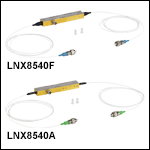
 ズーム
ズーム
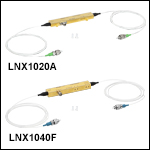
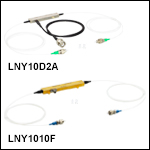
 LN変調器(ファイバ結合型EO変調器)830 nm~1090 nm
LN変調器(ファイバ結合型EO変調器)830 nm~1090 nm